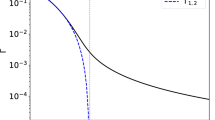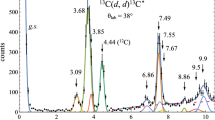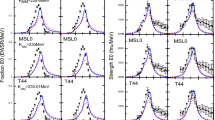Abstract
The collective excitation phenomena in atomic nuclei are studied in two different formulations of the random-phase approximation (RPA): (i) RPA based on correlated realistic nucleon-nucleon interactions constructed within the unitary correlation operator method (UCOM) and (ii) relativistic RPA derived from effective Lagrangians with density-dependent meson-exchange interactions. The former includes the dominant interaction-induced short-range central and tensor correlations by means of unitary transformation. It is shown that UCOM-RPA correlations induced by collective nuclear vibrations recover a part of the residual long-range correlations that are not explicitly included in the UCOM Hartree-Fock ground state. Both RPA models are employed in studies of the isoscalar giant monopole resonance in closed-shell nuclei across the nuclide chart, with an emphasis on the sensitivity of its properties on the constraints for the range of the UCOM correlation functions. Within the relativistic quasiparticle RPA (RQRPA) based on the relativistic Hartree-Bogolyubov model, the occurrence of pronounced low-lying dipole excitations is predicted in nuclei towards the proton drip line. From the analysis of the transition densities and the structure of the RQRPA amplitudes, it is shown that these states correspond to the proton pygmy dipole resonance.
Similar content being viewed by others
References
D. Vautherin and D. M. Brink, Phys. Rev. C 5, 626 (1972).
J. Dechargé and D. Gogny, Phys. Rev. C 21, 1568 (1980).
D. Vretenar, A. V. Afanasjev, G. A. Lalazissis, and P. Ring, Phys. Rep. 409, 101 (2005).
R. B. Wiringa, V. Stoks, and R. Schiavilla, Phys. Rev. C 51, 38 (1995).
R. Machleidt, Phys. Rev. C 63, 024001 (2001).
D. R. Entem and R. Machleidt, Phys. Lett. B 524, 93 (2002).
S. C. Pieper, R. B. Wiringa, and J. Carlson, Phys. Rev. C 70, 054325 (2004).
P. Navrátil, J. P. Vary, and B. R. Barrett, Phys. Rev. C 62, 054311 (2000).
S. C. Pieper et al., Phys. Rev. C 64, 014001 (2001).
E. Epelbaum et al., Phys. Rev. C 66, 064001 (2002).
H. Feldmeier, T. Neff, R. Roth, and J. Schnack, Nucl. Phys. A 632, 61 (1998).
T. Neff and H. Feldmeier, Nucl. Phys. A 713, 311(2003).
R. Roth, T. Neff, H. Hergert, and H. Feldmeier, Nucl. Phys. A 745, 3 (2004).
R. Roth, H. Hergert, P. Papakonstantinou, et al., Phys. Rev. C 72, 034002 (2005).
S. K. Bogner, T. T. S. Kuo, and A. Schwenk, Phys. Rep. 386, 1 (2003).
D. J. Rowe, Nuclear Collective Motion (Methuen, London, 1970).
P.-G. Reinhard and J. Friedrich, Z. Phys. A 321, 619 (1985).
M. Matsuo, Nucl. Phys. A 696, 371 (2001).
J. Terasaki, J. Engel, M. Bender, et al., Phys. Rev. C 71, 034310 (2005).
D. Sarchi, P. F. Bortignon, and G. Coló, Phys. Lett. B 601, 27 (2004).
N. Paar, P. Ring, T. Nikšić, and D. Vretenar, Phys. Rev. C 67, 034312 (2003).
L. G. Cao and Z. Y. Ma, Phys. Rev. C 71, 034305 (2005).
D. Vretenar, N. Paar, P. Ring, and G. A. Lalazissis, Nucl. Phys. A 692, 496 (2001).
N. Paar, D. Vretenar, and P. Ring, Phys. Rev. Lett. 94, 182501 (2005).
A. Leistenschneider et al., Phys. Rev. Lett. 86, 5442 (2001).
L. Coraggio et al., Phys. Rev. C 68, 034320 (2003).
V. I. Isakov et al., Eur. Phys. J. A 14, 29 (2002).
G. A. Lalazissis, J. König, and P. Ring, Phys. Rev. C 55, 540 (1997).
H. Esbensen and G. F. Bertsch, Phys. Rev. C 28, 355 (1983).
G. Audi and A. Wapstra, Nucl. Phys. A 595, 409 (1995).
N. Ullah and D. J. Rowe, Phys. Rev. 188, 1640 (1969).
T. Nikšić, D. Vretenar, P. Finelli, and P. Ring, Phys. Rev. C 66, 024306 (2002).
T. Nikšić, D. Vretenar, and P. Ring, Phys. Rev. C 66, 064302 (2002).
S. Drożdż, S. Nishizaki, J. Speth, and J. Wambach, Phys. Rep. 197, 1 (1990).
D. H. Youngblood, H. L. Clark, and Y.-W. Lui, Phys. Rev. Lett. 82, 691 (1999).
S. Shlomo and D. H. Youngblood, Phys. Rev. C 47, 529 (1993).
M. M. Sharma and M. N. Harakeh, Phys. Rev. C 38, 2562 (1988).
Y. Suzuki, K. Ikeda, and H. Sato, Prog. Theor. Phys. 83, 180 (1990).
N. Paar, T. Nikšić, D. Vretenar, and P. Ring, Phys. Lett. B 606, 288 (2005).
N. Paar, T. Nikšić, D. Vretenar, and P. Ring, Int. J. Mod. Phys. E 14, 1 (2005).
N. Paar, P. Papakonstantinou, V. Yu. Ponomarev, and J. Wambach, Phys. Latt. B 624, 195 (2005).
N. Paar, T. Nikšić, D. Vretenar, and P. Ring, Phys. Rev. C 69, 054303 (2004).
Author information
Authors and Affiliations
Additional information
The text was submitted by the authors in English.
Rights and permissions
About this article
Cite this article
Paar, N., Papakonstantinou, P., Hergert, H. et al. Collective excitations in the unitary correlation operator method and relativistic QRPA studies of exotic nuclei. Phys. Atom. Nuclei 69, 1345–1352 (2006). https://doi.org/10.1134/S1063778806080114
Received:
Issue Date:
DOI: https://doi.org/10.1134/S1063778806080114




